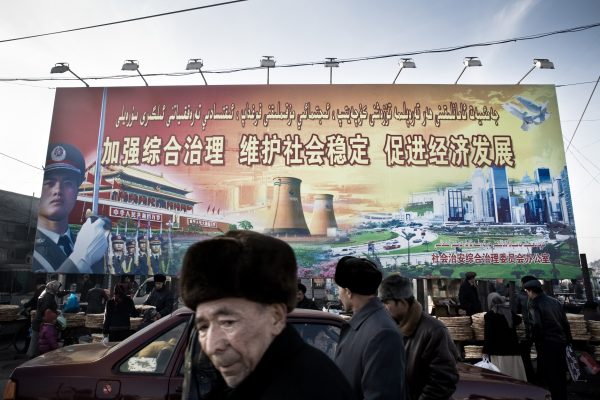The ēn/wēi stratagem continues in the People’s Republic of China (PRC) today. But recent unrest in the Tibetan Autonomous Region, the Xinjiang Uyghur Autonomous Region and elsewhere reminds us of the inherent limits of these tactics of paternalistic co-option and repression.
Over the past decade China has witnessed an ugly spate of ethnic protest and violence, leading some to prognosticate a ‘ticking time bomb’ of inter-ethnic hostilities.
In 2008, Tibetan areas erupted in protest and a year later nearly 200 people were brutally murdered in a bloody street riot in the Xinjiang regional capital of Ürümqi. Since coming to power in 2012, President Xi Jinping has faced a troubling wave of ethnic and religious embedded violence that has left nearly a thousand people dead. More worrying for Chinese leaders, the bloodshed is now spreading into major urban areas in China proper. The 2013 suicide car bombing in Tiananmen Square and 2014 Kunming train station attack, in particular, brought these once distant concerns to the very centre of power and public attention.
Yet these incidents are more cyclical and anomalous than systemic and incendiary. The increased density of transport and communication links engenders new spaces for ethnic misunderstanding and conflict in today’s China, though it is impossible to say with any level of empirical certainty whether inter-ethnic relations are any worse (at a national level, at least) than they were a decade ago, let alone during the tumultuous Cultural Revolution.
In managing these ‘ethnic contradictions’, the ruling Chinese Communist Party (CCP) relies on the same carrot and stick tactics as previous Chinese regimes: co-opting minority elites, encouraging and monitoring compliance at the grassroots level while eradicating pockets of resistance with brute force.
Nearly 7 per cent of all ethnic minorities in China are members of the CCP and many more are directly employed by the state. While most hold largely minor or ceremonial positions, some — such as the new director of the National Energy Agency, Nur Bekri, and the head of the Secretariat of the CCP Central Committee, Yang Jing — are in positions of real authority. Ordinary minorities enjoy a range of preferential state benefits, such as massive fiscal transfers and investment in minority regions; employment quotas in the public sector; bonus points on the university entrance exam; certain exemptions from family planning restrictions; and the right to preserve (within limits) their own cultures, languages and religions. Many minorities live in semi-autonomous administrative units and largely segregated ethnic communities.
Yet those that dare to openly resist CCP rule are efficiently and mercilessly silenced through the extensive domestic security apparatuses and judicial/extra-judicial legal system. China spends more on domestic security than it does on national defence. And the disparate punishments meted out to the Han intellectual Liu Xiaobo (11 years in prison for ‘inciting subversion of state power’) and the Uyghur economist Ilham Tohti (life in prison for ‘separatism’) highlight the different ethnic yardsticks for political loyalty in the PRC.
This structure of ethnic clientelism buys a begrudging acquiescence and conformity among most ethnic minorities, but the lack of social cohesion (especially in Tibet and Xinjiang) impedes multi-ethnic interactions, inter-ethnic trust and the sense of shared national belonging necessary for a healthy civil pluralism. The result is a vexing nest of ethnic antagonisms that continues to serve as a significant yet manageable irritant for party leaders. China’s ethnic troubles are nothing like those of Nigeria, Burma, Sri Lanka and other ‘severely divided societies’, where leading expert Donald Horowitz finds endemic ethnic conflict.
Despite their strategic distribution in resource-rich border regions, China’s ethnic minorities are far too small in number (about 114 million, or less than 9 per cent of the total population) and peripheral to the chief concerns of the party-state to pose an acute policy challenge. In fact, the divisions among those classified as part of the Han ethnic majority (along regional, cultural, linguistic, class and religious lines) pose a far more significant threat to CCP rule than the rift between the Han and non- Han minorities. The party-state might collapse one day but a USSR-style ethno-territorial implosion is highly unlikely.
Equally important, the coercive power and reach of the party-state ensures a level of stability that makes recent metaphors — Xinjiang as China’s Chechnya and Tibet as China’s Palestine — highly misleading. Like other multi-ethnic societies, China faces a range of challenges in managing ethnic diversity but nothing on the order of an ‘ethnic crisis’.
In the past, a mere 20,000 officials governed the vast Qing empire; today, over 85 million CCP members and a further 10 plus million security personnel patrol nearly all aspects of social life. This far more intrusive and panoptic form of governance keeps a fairly secure lid on any immediate sources of instability while patching over longer-term social and political fragilities.
At present, ethnic troubles are largely isolated to the remote and sparsely populated regions of Xinjiang and Tibet. Here inter-ethnic trust is in short supply, with a strong sense of ethnic, religious and physical difference. In the past, these regions experienced long periods outside the orb of Chinese influence. And today, many young Uyghurs and Tibetans struggle to adapt to a rapidly modernising society dominated by the Han Chinese language and culture.
In sum, the Chinese party-state expends considerable resources in an effort to engineer ‘ethnic harmony’. Its authoritarian controls, ironically, attenuates ethnic contradictions in the short term, even if they erupt from time to time. Yet the lack of genuine openness, equality and grassroots community building forestalls the conditions required for a robust, inclusive and enduring ethnic pluralism.
James Leibold is a Senior Lecturer in Politics and Asian Studies at La Trobe University. He is the author of Ethnic Policy in China: Is Reform Inevitable? (Honolulu: East-West Center, 2013). This article appeared in the most recent edition of the East Asia Forum Quarterly, ‘Asia’s Minorities‘.

